Cadillac CTS-V Coupe SCCA race car takes on all comers – Click above for high-res image gallery
The last time Cadillac lined up for the World Challenge Series from 2004 to 2007, it was competing with the CTS-V sedan. As put by an understated Jim Vurpillat, Cadillac's global head of marketing, "We've been here before and had some success."
The CTS-V Coupe race cars were plucked from the same line as cars headed to dealerships.
By "some success," he means that the four-door roared off with the championship in its second and fourth years. The team has a steep road to climb if they're going to relive that kind of winning percentage with its new CTS-V Coupe, but, having watched the package shred the Long Beach circuit last weekend, there's no doubt they have a car that will be able to do it... eventually.
With just six months to prepare for the racing season, the two CTS-V Coupes piloted by Johnny O'Connell and Andy Pilgrim were built at the Lansing, Michigan plant, plucked from the same line as cars headed to dealerships. They were then taken to Pratt & Miller, the same firm that prepped the championship-winning CTS-V sedans, to be overhauled.
Continue Reading Why Cadillac hasn't found success yet in World Challenge Series, and why it's not giving up...
All the body panels were replaced with carbon fiber bits, and the racer maintains a pretty stock look, save for the bulked-up fender flares and kickout panel that houses the side-exit exhaust. That has helped get the car under its mandated 3,100-pound race weight. The team uses tungsten bars for ballast and balance tweaking.
Under the vented bonnet, the supercharged 6.2-liter V8 from the showroom car is stripped of its supercharger, and the now-naturally aspirated lump is repositioned as low and far back in the engine bay as possible. It puts power down through a six-speed sequential transmission that the driver shifts, not with paddles, but with a stubby stick jutting up from the center console. Brembos all around handle stopping duties.
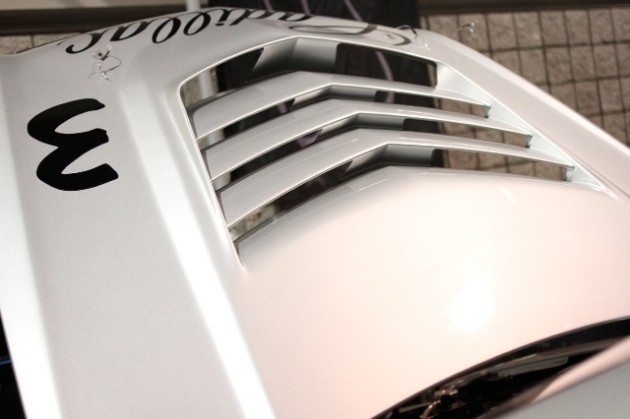
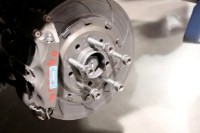
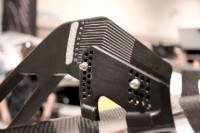
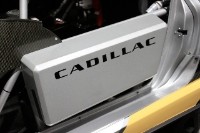
For driver safety, there's a net on both sides of the head and a carbon-and-honeycomb box structure between the rollbar and door skin. To keep the driver cool, there's an air intake in the rear-quarter glass that runs to a coolbox filled with water and ice. The chilled air is then channeled to three locations: the perforations in the driver's seat, to a system that cools the driver's suit, and to the helmet. There is also a thermos of chilled water for drinking, activated by a button on the steering wheel.
That is one of many buttons on the Formula 1-esque steering wheel. Another notable switch is the Line Lock; World Challenge Series utilizes standing starts (a side effect of which is the comical sight of an official literally zig-zagging through the starting grid to line up the cars), so when the driver presses the Line Lock, it holds the engine at a set speed and locks the car's brakes. The driver can then let go of the clutch and just focus on hitting the go pedal when the race begins.
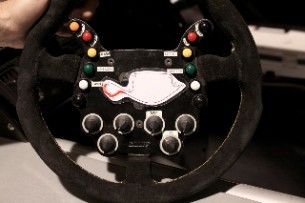
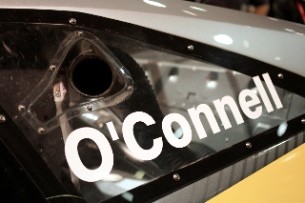
Out back, the overhead spars that support the infinitely-adjustable rear wing are what you get "when you give an engineer too much time." The rules allow the wing to line up with the rear line of the car, but if the spars were fixed from the bottom they would impede access to the trunk. That would be a problem because the trunk houses the fuel filler nozzles (though a WCS race is only 50 minutes in duration, so there's no need to refuel mid-race), ancillaries, and an intake to channel cooling air to the differential and transmission.
A 1.7-inch air restrictor and no supercharger cuts horsepower from 556 in the street car to 460 in the race car.
It's a sleek piece of kit – an evil, motorized Mondrian. But it is not, so far, a winner. That is, at least in part, because the SCCA wants to make sure the CTS-V Coupe does not repeat the dominant feats of its four-door predecessor. At least, not this year.
Said driver Johnny O'Connell, who switched to World Challenge after ten years in GM's American Le Mans Series Corvette program, "Cadillac came in and was very dominant – they made a start that the governing body probably found embarrassing, so we're on lifetime double-secret probation."
What he's talking about is the WCS' Equivalency Formula in the GT class, which tries to put the various makes in the series on level-ish ground. This is done by setting a weight for a particular entrant – the Cadillac has to come in at 3,100 pounds – then applying an air restrictor to choke the ponies.
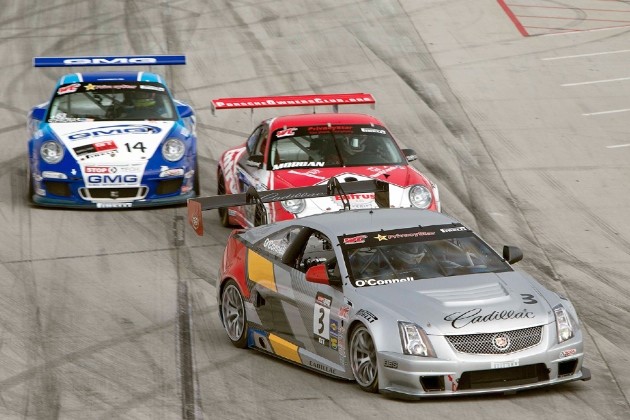
The race version of the CTS-V Coupe breathes through a restrictor that is just 1.7 inches in diameter. That volume of air, along with the loss of the supercharger, cuts horsepower from 556 in the street car to 460 in the race car.
The result, according to O'Connell, is that "the Corvettes are doing 160 miles per hour down the straight, the Porsches are doing 154, we're doing 149. You'd kill for two more miles an hour. We're down by more than ten. The sanctioning body is holding us back." When asked who he thinks the formula favors, he said, only half jokingly, "Oh, the Porsche, Vette, Viper, Volvo, and Mustang." In other words, every other car in the class.
Volumes of in-car telemetry are stored in the car and downloaded by the governing body, which can then judge – based on top speeds, cornering speeds and the like – who needs to be reined in and who can be allowed a little more power. After not coming any higher than fourth so far this year, the hope is that the powers-that-be will let the CTS-V Coupe breathe a little easier pretty soon.
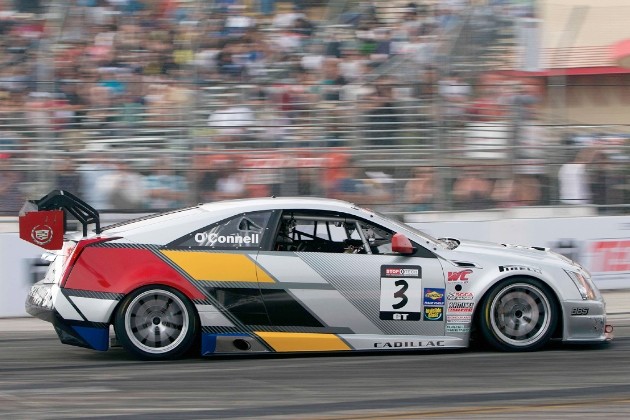
O'Connell's sentiments – those of a committed racer – are tempered by Vurpillat, who said of the sanctioning body, "They have a hard job. You've got mid-engined Porsches, you've got Vipers and Volvos – we just hope these guys will look at the data and make the right decision."
The Cadillac sounds like the alarm that God will use as an early warning system for the Apocalpyse.
As to why and how long Cadillac might endure such a handicap, Vurpillat said they've committed two years to the series. For the time being, it is more important to him to get the racing CTS-V Coupe in front of people who might not otherwise have Cadillac on their minds, and doing so in a series that allows people to equate the race car with the one they can buy... you know, what that other so-called stock-car racing series used to be. And so far everyone is happy with the program.
"The biggest misunderstanding is that we build cars that are large, comfortable and soft," said Vurpillat. "Nothing could be further from the truth.
"When we made the decision to go racing, we said the series needed to be production-based, we needed to have some experience in it, and it needed a short development time. It's a long race season, but we've still had no mechanical failures, no suspensions break or engines break, and every lap we can run we can get better. From that end we're very excited."
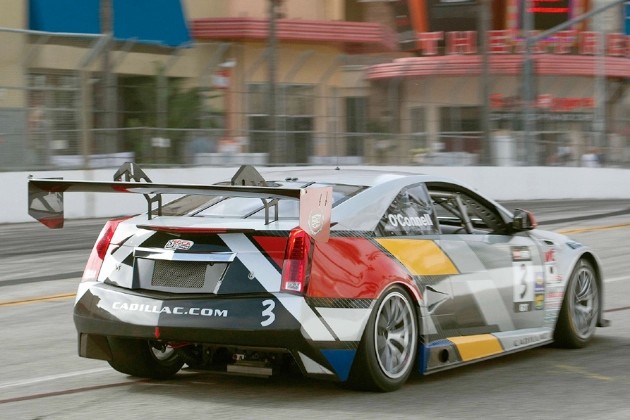
As for the racing itself, we found it plenty exciting – close action with heaps of passing, and the sounds are unforgettable. Whereas the Corvettes wail like murder on PCP, the Cadillac sounds like the alarm that God will use as an early warning system for the Apocalypse.
As for the drivers' excitement – as in, spraying bubbly on the top step of the podium – O'Connell promises that's coming. He came in seventh at the Long Beach race, with teammate Andy Pilgrim taking eighth, but as America's winningest Le Mans Series driver, we'll give O'Connell the benefit of some time.
"It's very early in the program, but we'll find a way. By halfway through the season I'll be angry if I don't a have a win."
The next World Challenge event takes place this weekend – April 29 to May 1 – at Miller Motorsports Park, and you can catch all the action on the VS cable network.


Sign in to post
Please sign in to leave a comment.
Continue